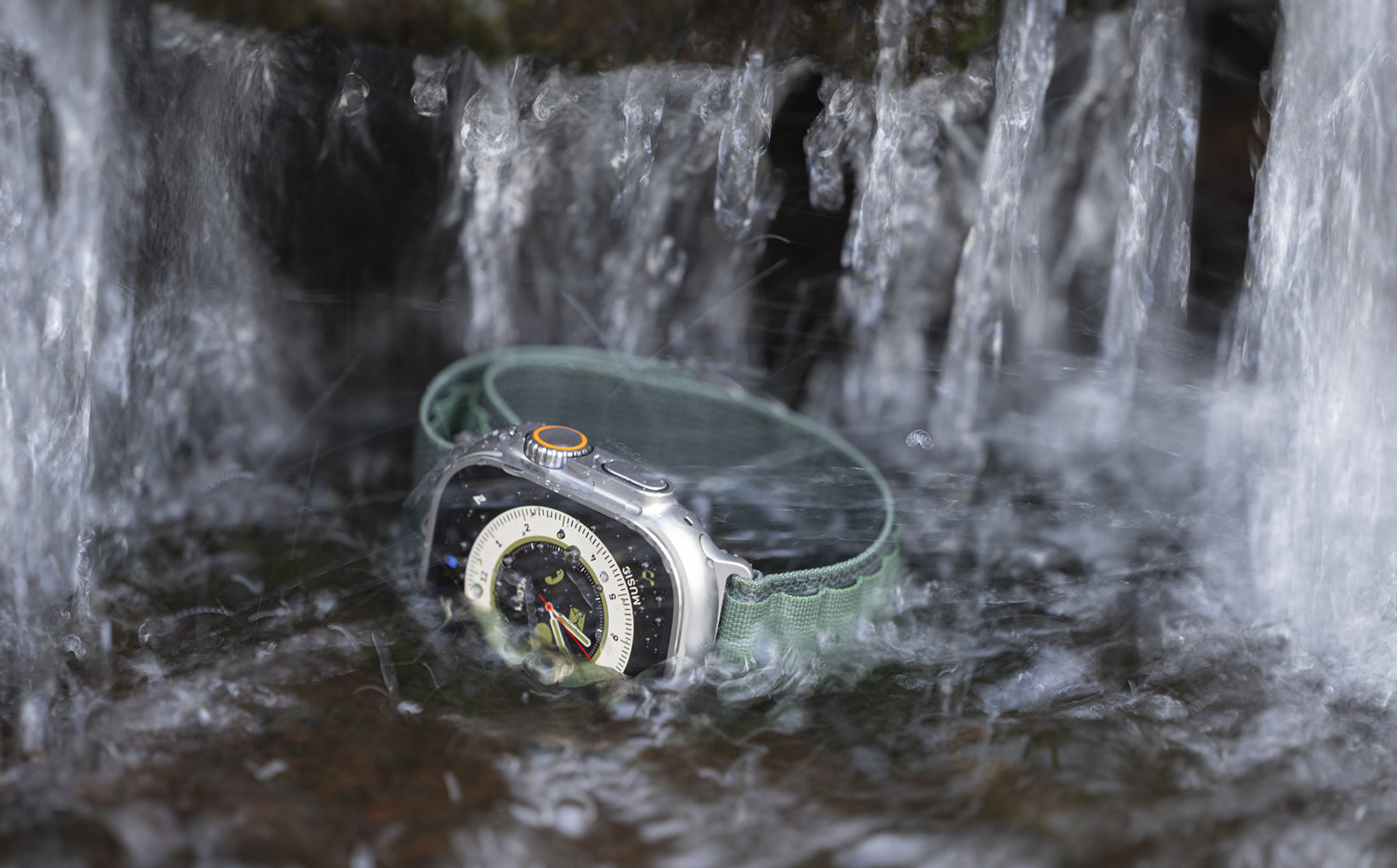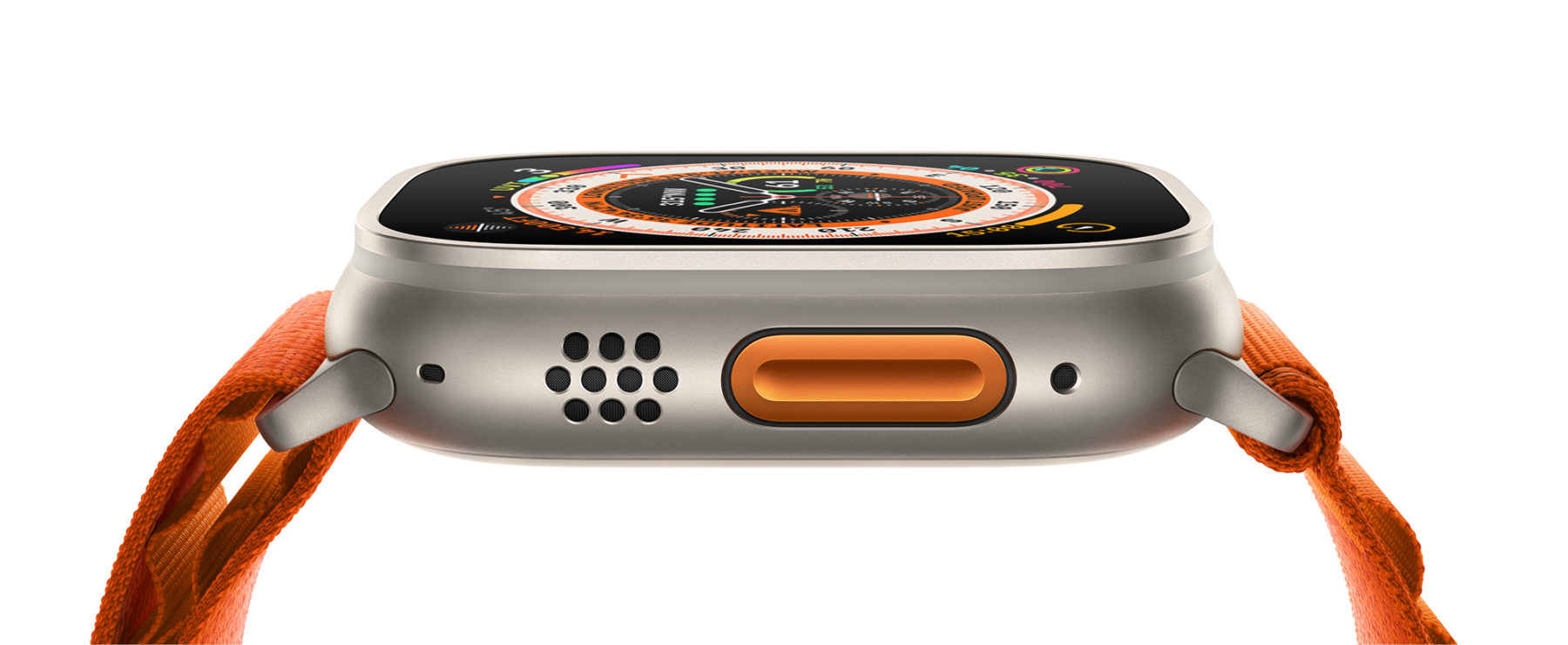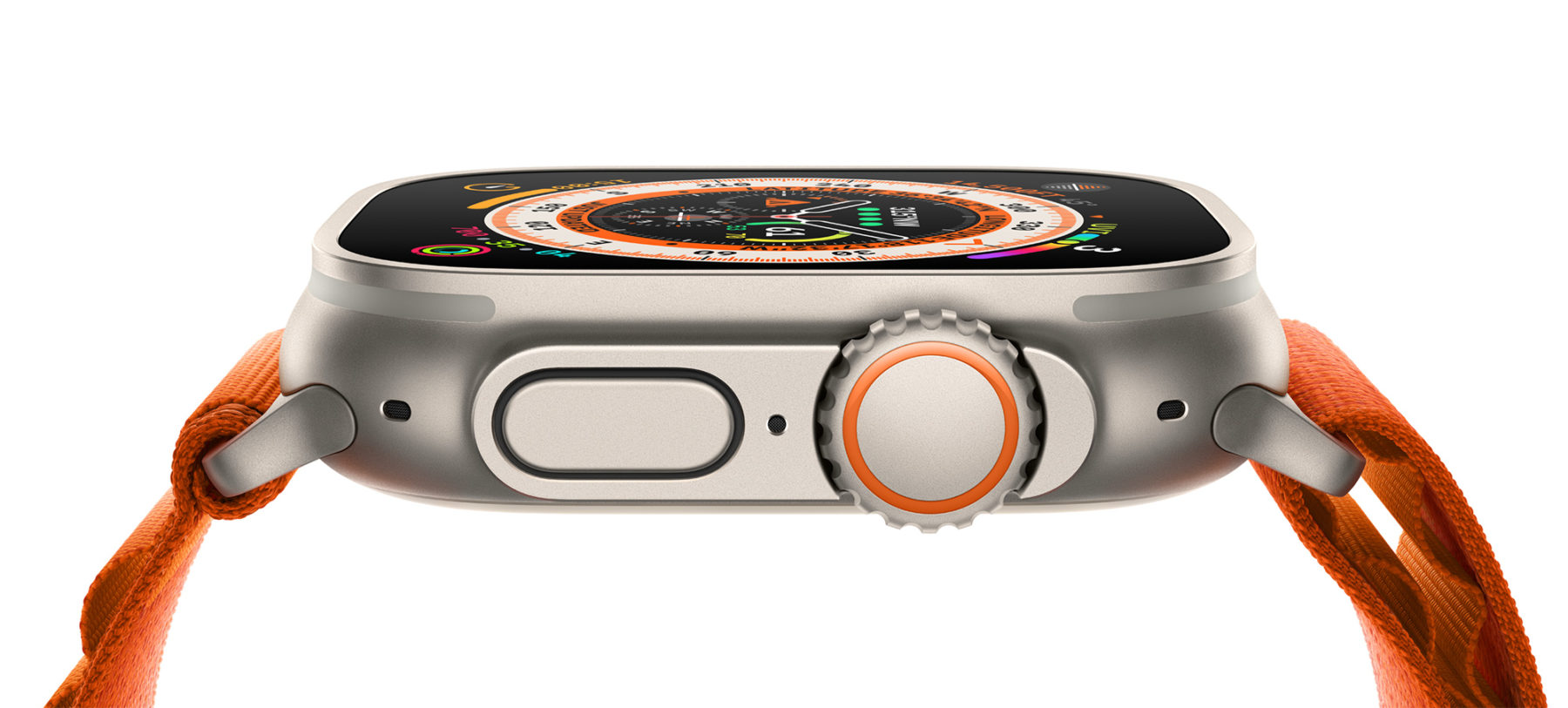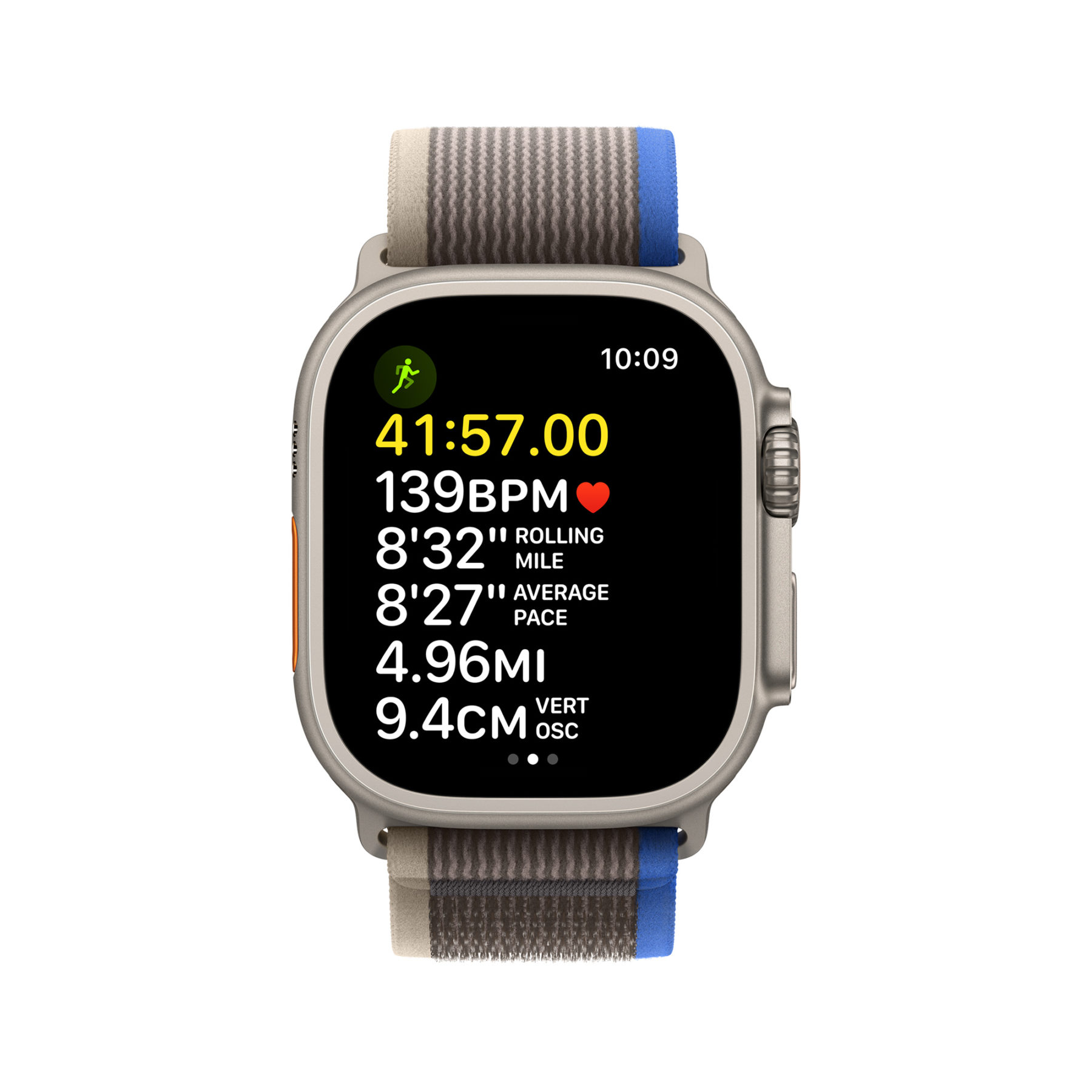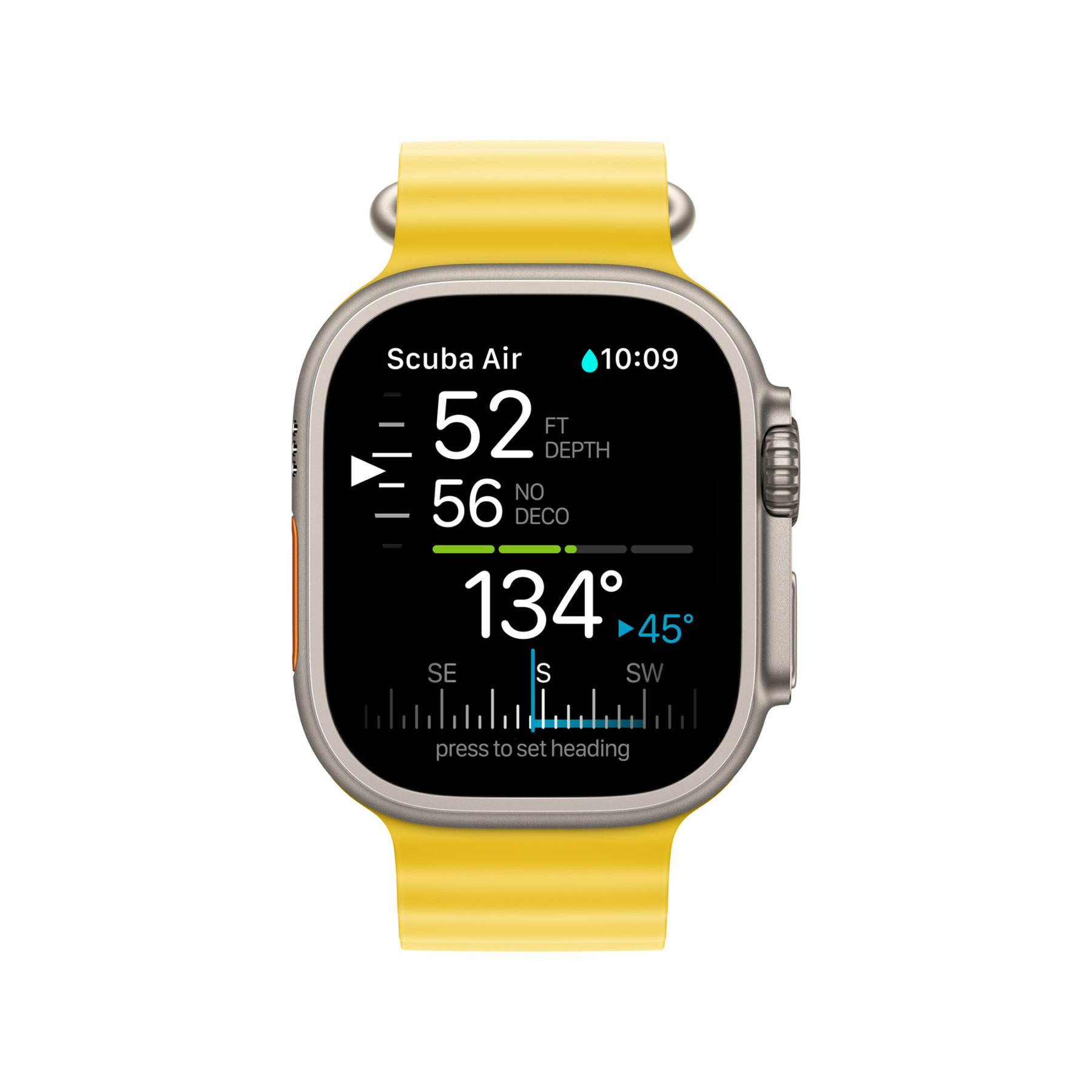Okay, so let’s address the elephant in the room. Has Apple trumped established players in the world of adventure-wearables, with its Apple Watch Ultra, to deliver the best-ever outdoor-oriented GPS watch for adventure athletes? And if so, should you cough up a not insignificant amount of cash for a sexy smartwatch that not only doubles as a dive computer and outdoor GPS, but also turns your coffee machine on in the morning?
The answer is, (drum roll please), “Yes… and no!” Or is that, “No… and yes!”?
“Get off the fence!” I hear you scream. But hear me out.
What Apple has delivered in the Apple Watch Ultra is arguably the most, advanced, durable and feature-rich smartwatch that simultaneously performs as a rugged full-featured GPS and precision training device. And for most of us mere mortals, it will be more than enough.
However, let’s begin with the blatantly obvious. If you are a super hardcore extreme adventurer heading off into remote wilderness for days and weeks on end, with a need for inbuilt OEM topo-maps or near endless battery life, then there is little doubt Garmin’s Solar series will be in your sights, or maybe Coros. Not because they are vastly superior devices but quite simply, because of their proprietary route-plotting and topographic maps combined with energy-saving modes that massively extend battery longevity.
But for nearly everybody else, in nearly every other location, in every other discipline and every other situation, the Apple Watch Ultra is not only going to deliver what you need, but also provide features you’ve previously only dreamt of. In fact, for triathletes, multi-sport athletes, runners, riders, swimmers, hikers, skiers and SCUBA divers (Yes SCUBA divers), The Apple Watch Ultra might just be the most spectacular piece of wearable tech you can presently adorn yourself with. Oh, and if like me, you like to duck off for a sneaky midweek ‘board-meeting’ at your local surf break, when you should be responding to urgent emails, then the Ultra should most definitely be on your watch list (see what I did there?).
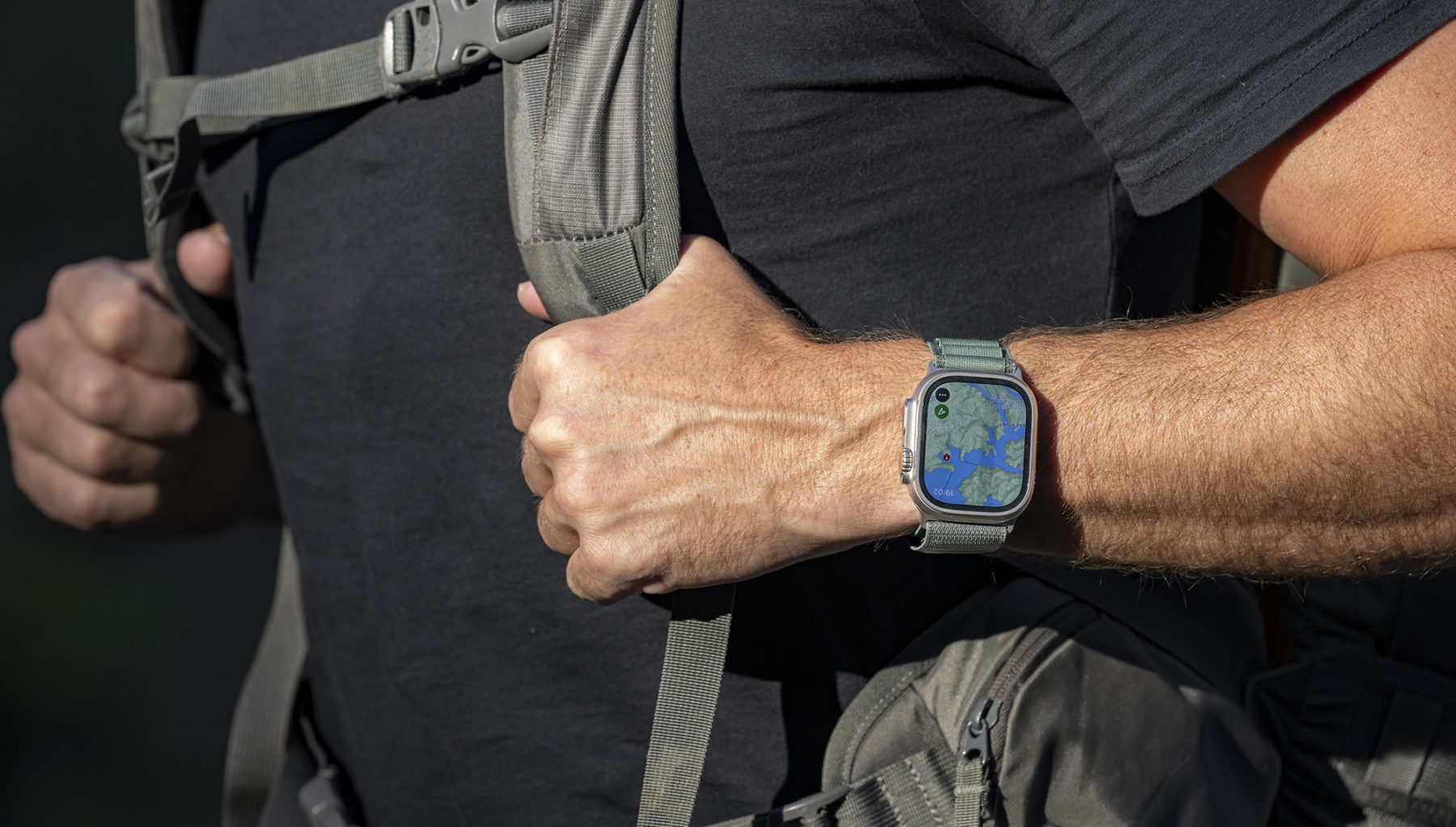
Importantly, the Apple Watch Ultra is not trying to be something it is not. It is not trying to promise months of GPS tracking on a single solar charge. Instead, Apple promote the Ultra as exceptional tech with an abundance of exclusive features and a dramatically extended battery-life. Apple is bringing a world of app-development and smartwatch technology into the mud, sand, snow and water; and doing so with a ‘Bang!’ Or more aptly, with the shrill, piercing wail of an 86-decibel emergency siren. But more on that later.
Design
There’s no denying the new Apple Watch Ultra stands out from the crowd in the fast-growing competitive world of GPS watches; 49mm x 44mm of Sapphire Crystal paired with 61 grams of body sensors, three speakers, three microphones and copious internal-tech in a rounded-rectangular aerospace titanium casing certainly delivers a ‘presence’ that cannot be ignored.
What is unique about the Apple Watch Ultra is the rugged looks do not appear to detract from its universal appeal. Even with an oversized digital crown and bright orange action button the Ultra appears stylish enough for the fedora hat-wearers of our world. The Ultra can be paired with easily swappable wristbands for custom looks, and performance, in varying pursuits. A Trail Loop delivers a thin, extremely lightweight, comfortable band with velcro-like closure for running and endurance sports. The Alpine Loop is for “explorers” who prefer a stitch-less high-strength band of dual layered nylon woven together and fastened with a titanium G-hook. And the Ocean Band is for watersport lovers and recreational divers, delivering a stretch rubber with customisable titanium buckle and optional extension strap to fit over a wetsuit.
Truth be told, I initially considered the interchangeable wristbands of Apple watches a bit of a gimmick but have surprisingly found myself mixing and matching my Ultra bands on a near daily basis with the Alpine Loop quickly becoming a favourite due to its comfort and security and the Ocean Band perfect for surfing.
The watch tends to rest on the wrist rather than wrapping around it, and for some this will be an annoyance, but for others, like myself, this weighty burliness is somewhat comforting, and the bulk is offset by Apple’s clean styling. The oversized digital crown is protected by a crown-guard and works both as a scroll-wheel and button, and two further buttons, including the bright orange action button, give the Ultra more manual control than touchscreen-only smartwatches.
The Action button is a fully customisable button programmable to activate workouts, drop waypoints, backtrack when navigating, turn on the torch or even record a Scuba Dive. I personally programmed the button to open my work-out app, and then to activate precision start. From there-on the same button manually recorded segments or a two-button sequence paused my workout.
For each different app the Action button varies in its capabilities. It takes a little getting used to and a mild annoyance is an inability to fully customise the button to work across all apps, or program multi button sequences, such as double-press or triple-press actions, to end workouts or answer/end calls etc. I’d love to see the Action button being used to its maximum potential in future firmware upgrades.
The bulky casing and rugged looks are not just for show, however. The aerospace-grade titanium and ceramic casing delivers exceptional corrosion resistance and strength to weight ratio, whilst the sapphire crystal display measures 9 out of 10 on the Mohs hardness scale (where diamonds are 10/10), making it one of the hardest, most scratch resistant materials on earth.
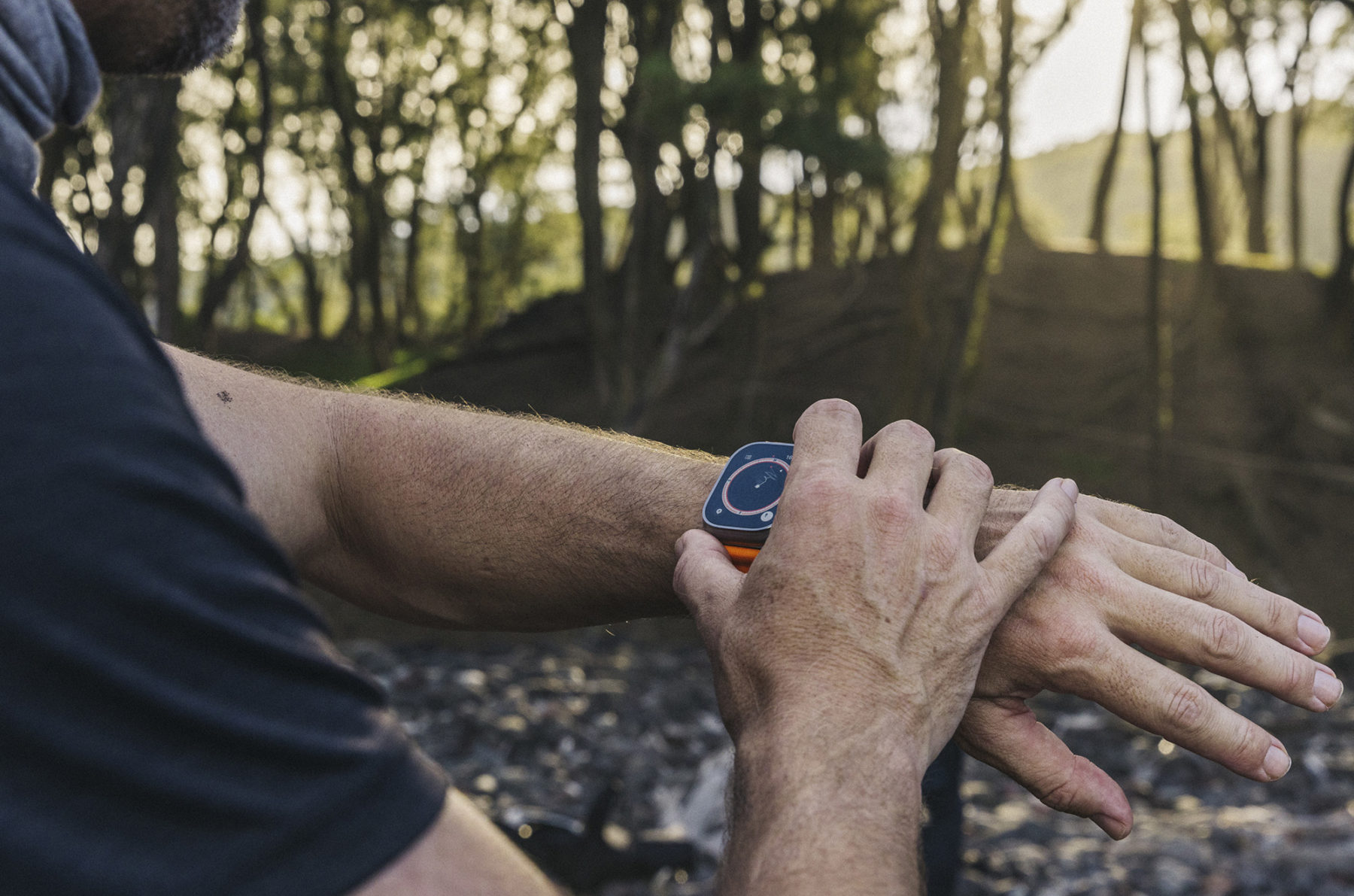
The Ultra’s ability to be worn in temperatures as low as -20 degrees Celsius and high as 55 degrees Celsius prove it’s not a device for fair weather only. Even so, in my experience, many devices developed to be worn in extreme cold don’t necessarily ‘operate’ without copious body warmth, but I haven’t yet been able to test the Ultra in such conditions. With many Ultra Apps still requiring a large degree of touchscreen input, the Ultra will potentially remain slightly handicapped in this arena until further development delivers crown and button only controls for conditions where frostbite, snow, ice or teeming rain might me an issue.
I was fortunate to catch up with National Geographic Adventurer and Explorer Wasfia Nazreen, who has been using the Apple Watch Ultra for several months, however, and she raved about the new kid on the block.
“As a high-altitude mountaineer, it’s critical to measure blood saturation levels, and having both Blood Oxygen and the ECG app on my wrist is incredible!” Nazreen says. Other favourites include the Compass app (for waypoints and when using the Backtrack feature to retrace steps) the customisable Action button (easy to use, even when wearing gloves) the temp sensor, women’s cycle tracking and the inbuilt comms (voice-memos, calls and messages).
Crucial information is measured using a mass of sensors, including dual-band GPS, accelerometer, gyroscope, electrical heart rate, optical HR, barometer, always-on altimeter, compass, SpO2, VO2max, body-temperature, water-temperature, depth gauge and more. Data is analysed via the watchOS 9 operating system and delivered to the Ultra’s bright 410 x 502 pixel, 2000nit OLED retina display. Now we’re not talking, ‘easy to view in a dark tent’ kind of display, but rather the Ultra can be viewed at arm’s length when backcountry skiing on a bluebird day, or at 20m under in murky water. The Ultra is twice as bright as the Apple Watch Series 8, surpassing nearly all other displays in the market. Importantly, display-brightness is customisable and the digital crown enables one-touch transition to a red-light night mode on the Wayfinder watch-face. Speaking of watch faces, Ultra users have the option of hundreds of watch face styles and configurations, downloaded to the Ultra itself, or via the IOS Watch app. The Watch app allows full customisation of each watch-face, with complications, as well as tailoring colour, app view, dock, Action button, notifications, sounds, haptics, and much more.
In the realms of health and fitness watchOS 9 also offers some of the most advanced metric and analysis available, such as vertical oscillation, ground contact time and stride length during running workouts. Information like time, distance, elevation, and heart rate are all available at a glance on the watches oversized display and users can easily scroll between views on the move for a mind-boggling array of data. Audible feedback of split times, heart rate zones and more is available through the Ultra’s dual-speakers or bluetooth earbuds as well as the ability to stream music or listen to tunes stored on the Ultra’s internal memory. Messaging, phone calls and voice memos utilise the Ultra’s triple microphone array and are available through Siri. There are still a few inconveniences like not being able to stop a workout when on a phone call, but hopefully these will be addressed in firmware updates.
In the field
There is an entire world of third-party fitness apps are available through the App Store, but the Ultra’s native Workout app is more than enough for most ‘everyday users’ and I personally found the app to be ideal for general running/cycling, and even surfing duties. I could easily view distance, speed, pace, heart rate (HR) and HR zones, and all data synced to the fitness and health apps on my iPhone. The Ultra also offers advanced workout features like automatic-detection and switching of disciplines for multi-sport workouts and – one of my favourites – an easily interpretable pace-diagram highlighting, in real time, if I am slower or faster than my intended pace. Post workout I can examine in-depth analysis of each individual workout, including workout locations (with maps), weather and routes, time and splits, distance and pace, calories, altitude, power output, heart rate data (including zones), cadence and more.
I have been a user of Strava for many years so it’s seamless integration with Apple Watch Ultra is a bonus. Strava Pro subscribers have access to their workout history, plus advanced Strava metrics like power data and customisable HR zones, as well as training options.
For getting off the beaten path, the compass app now enables intrepid users to input waypoints, follow a bearing with distance information and backtrack routes. Dual Band (L1 and L5) capabilities across GPS,Glonass, Galileo, BeiDou, QZSS provides the most accurate location tracking of any system, even in complex and dense environments. For users who require advanced backcountry navigation, third-party apps like WorkOutdoors, GaiaGPS, Kamoot, All-Trails and TopoMaps+ are your new best friend.
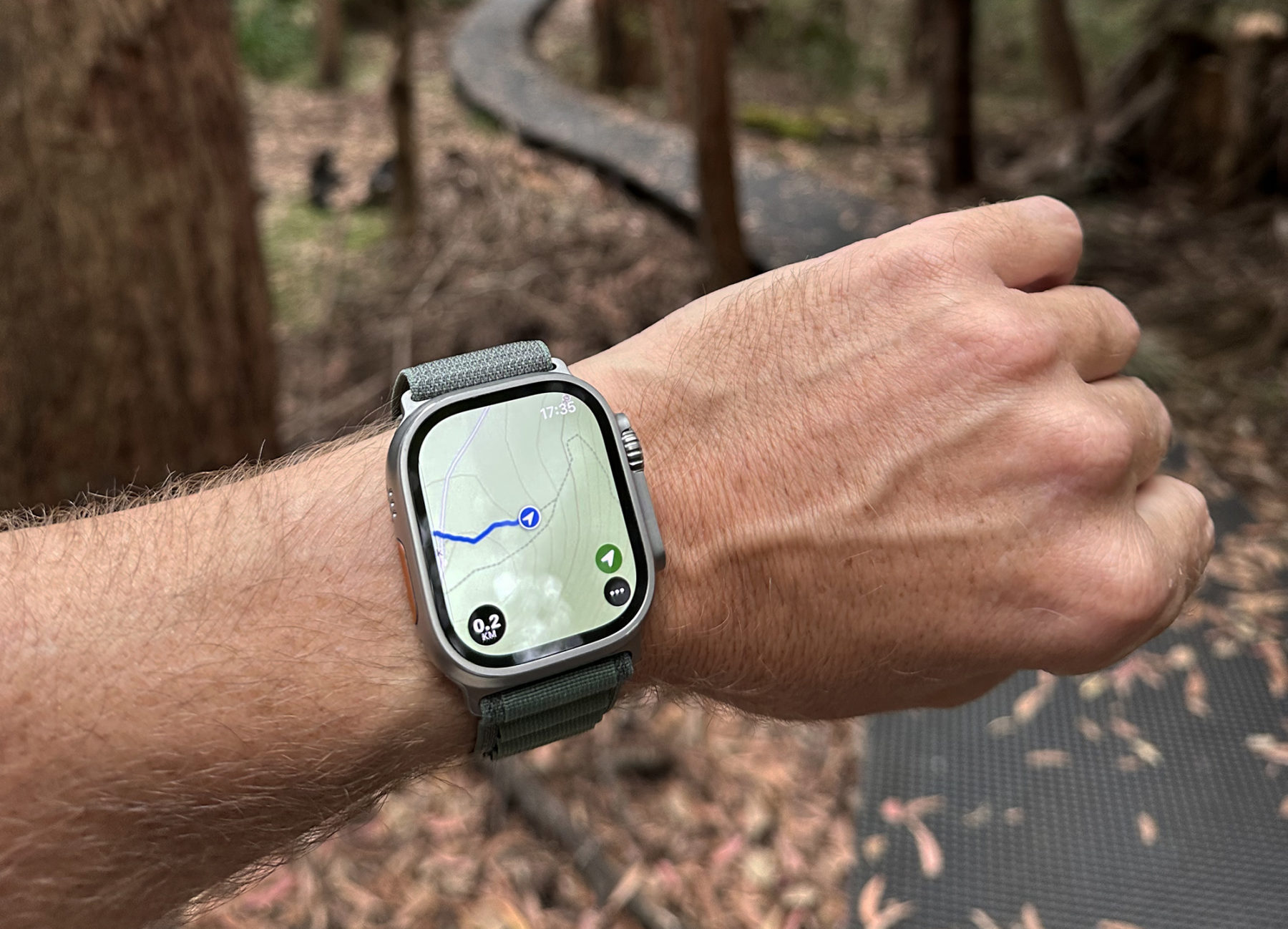
Some of these apps offer turn by turn instructions whilst others allow the user to download off-line topographic maps for remote navigation. I’ve been a fan of TopoMaps+ for years, mainly for double checking where the hell my campsite is when returning from backcountry split-boarding antics in a white out. The app also allows me to plan, navigate and backtrack routes, all on my iPhone. On my Ultra I can now use TopoMaps+ to mark waypoints, deliver bearing & distance observations, record tracks, and retrace my route if need be. Whilst the routes created on my Ultra sync to my iPhone, TopoMap+ doesn’t appear now to reverse the sharing to provide GPX files, or saved routes and tracks to my watch.
For route planning GaiaGPS seems, at present, to be one of the best, offering waypoint creation and route-plotting via PC or smartphone. Using my Gaia IOS app I can send routes directly to the Ultra, even with turn-by-turn instructions. WorkOutdoors also syncs GPX files imported to the WorkOutdoors iPhone app. All in all the watchOS topo and navigation apps are very much nearly there, but still need a little tweaking to offer a system capable of rivalling Garmin.
Where the Ultra excels over all others however is in the water. The most noticeable evidence of the Ultra’s aquatic brilliance is through Apple’s collaboration with Huish Outdoors to develop the Oceanic+ app. Oceanic+ converts the Apple Watch Ultra into a fully featured dive computer, capable of recording and logging dives to 40-metres. Very few GPS watches are certified for SCUBA but the Ultra features a water-lock and is certified to WR100 and EN 13319, an internationally recognised standard for dive accessories. The Oceanic+ dive planner integrates dive conditions, tides, water temperature and even visibility and currents posted by other users.
I had the opportunity to join award-winning wildlife photographer and scuba expedition leader Nadia Aly while diving in Hawaii, and she explained the benefits of the Ultra over dedicated dive computers.
“Oceanic+ offers recreational divers the same data in a much more user-friendly interface. The simplicity and ease of use just can’t be beat! Believe it or not, most dive computers are hard to figure out, they have complicated menus, and don’t have great user interfaces.”
My testing of the unit on multiple dives in both Australia and Hawaii proved Nadia’s comments true. I was mind-blown; not only does the Ultra perform as a fully featured dive computer but it even surpasses much of its competition with an easy-to-use interface, super bright display, haptic feedback, and intelligent use of digital crown and action button. I was easily able to plan dives, program Air or Nitrox and target depths, record dives and keep track of all vital dive data during a SCUBA session.
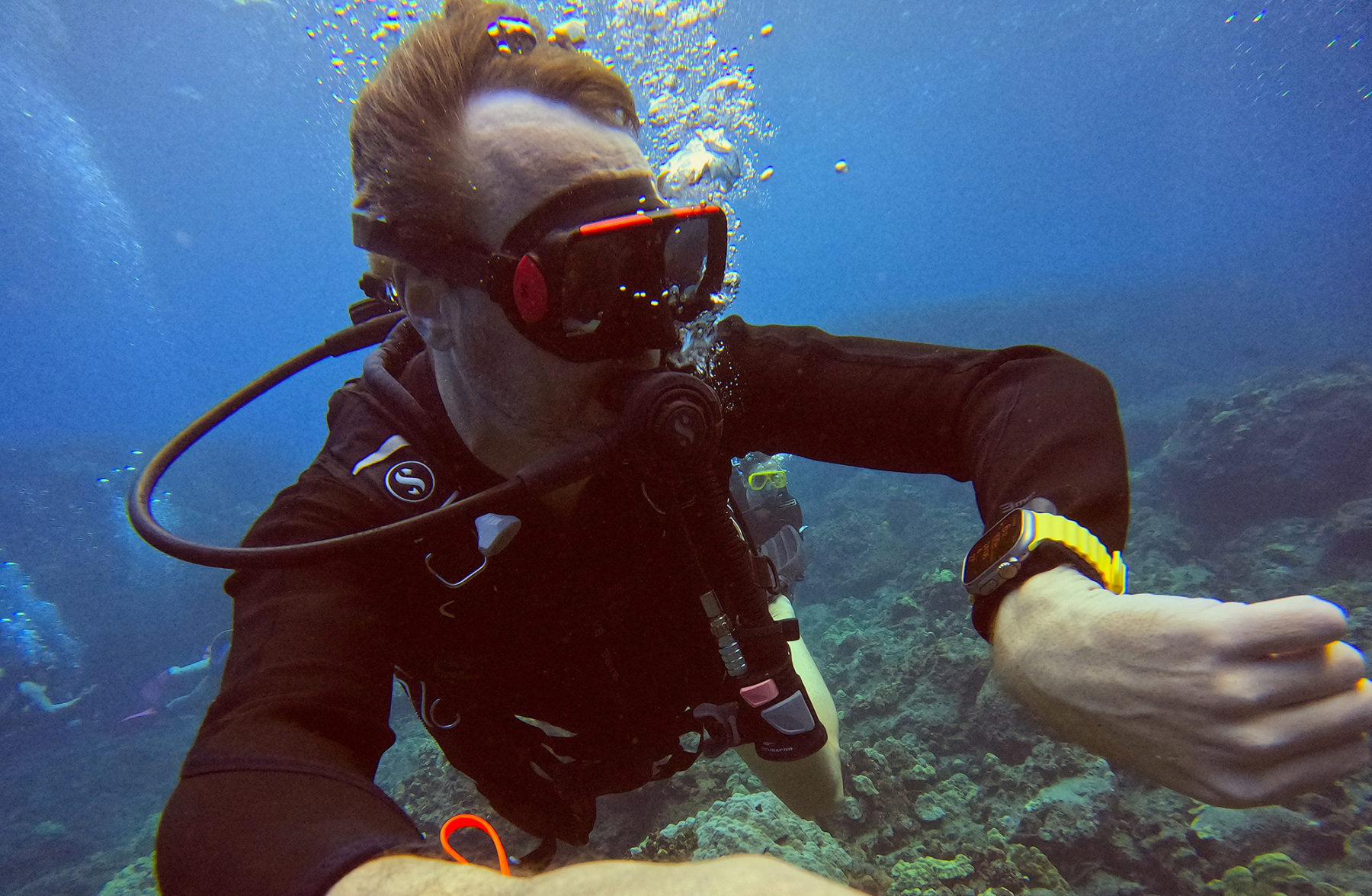
Underwater, haptic feedback resonated through my wetsuit to inform me I’d reached my max dive depth. I could use the Ultra’s digital crown to scroll though dive data like depth, time on bottom, time to surface and even to set a bearing. My wrist buzzed and my watch flashed if I hit my target depth, ascended too fast, and for my safety/decompression stop, where the Ultra displayed a countdown timer.
Post dive, I was able to immediately view my ‘OK to fly’ time as well as access my basic dive log on the Ultra. The dive log automatically syncs to the Oceanic+ IOS app for more in-depth dive data, including GPS entry and exit locations, dive profile and statistics. On the IOS app, users can assess graphs of depth, temperature, ascent speed and no-decompression-time as well as input data like weights used, surface conditions and visibility.
After my first two dives I asked Nadia Aly if maybe I was over-frothing, but she replied, “This is a huge game changer for me and many other divers. The fact that I can wake up, go to the gym, track my workout, hop on a boat and then scuba dive with the same device is just amazing!”
Whilst the SCUBA community is certainly niche, The Ultra’s aquatic capabilities are not just limited to those who enjoy exploring under the waves. Surfline transitions the Ultra into a dedicated surf watch. I use Surfline to check local conditions and receive alerts when my local breaks turn on. I can also use Surfline to record each surf as a workout, with each wave recorded on GPS, alongside swell size, wind direction and even the water temperature. All info is uploaded to my IOS Surfline App so, if need be, I have proof of that ‘epic session’ when boasting to mates at the pub.
Whether surfing, diving, running, snorkelling (see our snorkelling guide, here), backcountry navigation of just doing your HIIT workout, there is a plethora of features, apps and modes for everybody. Back at home, the Ultra even works hand in hand with CarPlay to deliver haptic feedback for turn-by-turn notifications enroute to my local trails. It even has crash detection if I am in a serious vehicle accident, using the Ultra’s accelerometer and gyroscope in conjunction with GPS, microphone activity, barometric pressure changes and machine learning algorithms to detect a serious vehicle accident. If a severe accident is detected the Ultra will display an alert, if the alert is not cancelled within 20-seconds the Ultra will call emergency services. If I am unresponsive, the watch even plays an emergency audio message to emergency services with latitudinal and longitudinal coordinates. And finally, if no signal is available and my iPhone 14 (or later) is close-by, Crash Detection uses the iPhone to send a notification using Emergency SOS via satellite if available. (Unfortunately, SOS is not yet available in Australia.)
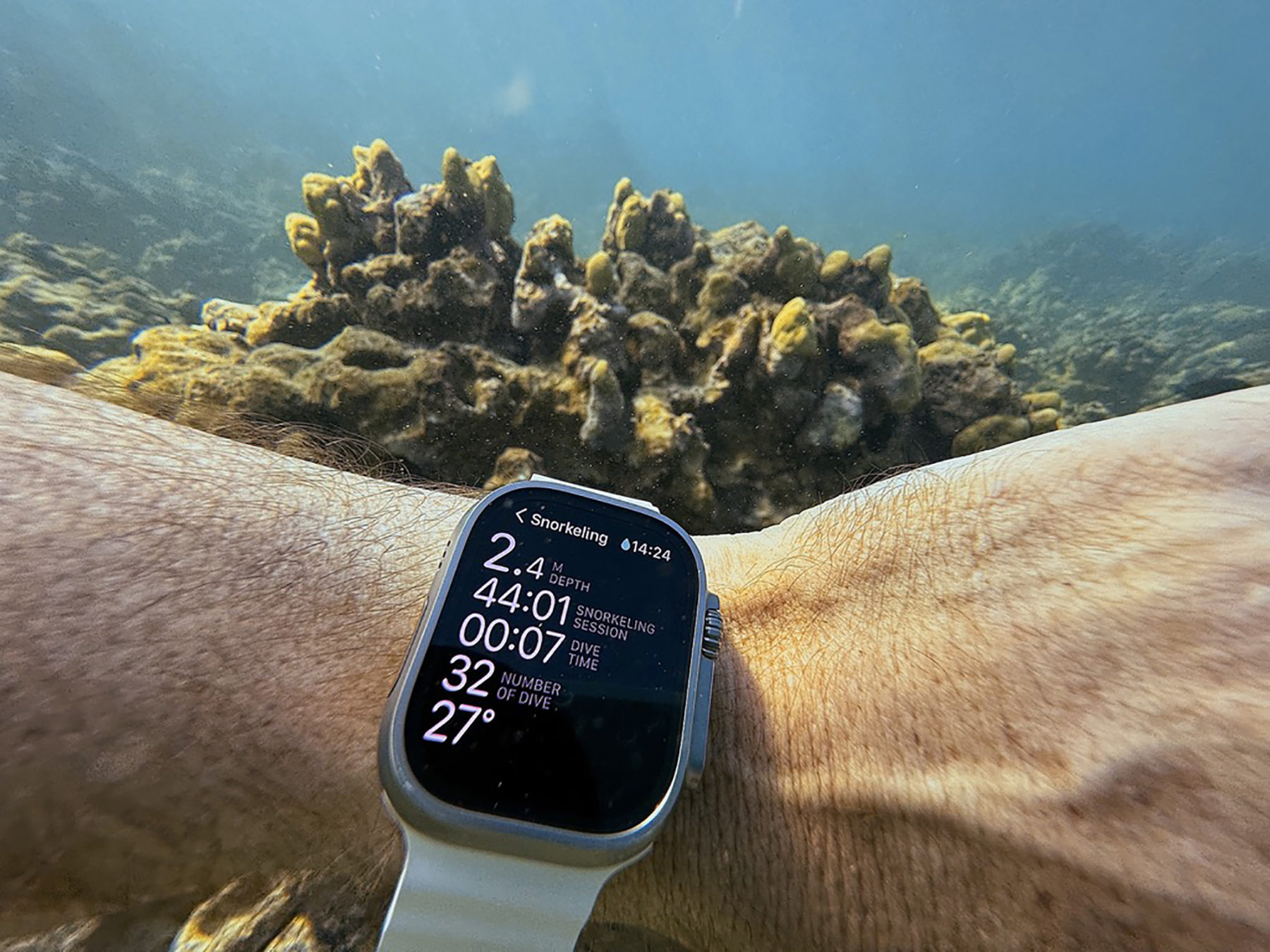
Assuming I make it to the trailhead, all the niceties of the Ultra still don’t seem to stop me from running into trees on my mountain bike, but hidden safety features help me here as well. The Ultra offers both an emergency siren and fall detection; the Ultra’s siren is an 86-decibel siren that Apple claims can be heard 180 metres away.
On a windy day at my local trails the siren was easily activated and able to pierce ambient noises at close quarters, but at 50m it was difficult to discern, and at further away the wind noise got the better of it. While not the claimed 180m, the Ultra certainly has the ability to draw attention to the plight of somebody well out of sight. Of course, if I manage to crash my bike and become unresponsive then the siren is not much use, but the Ultra still has a trick ‘on a sleeve’ (get it?). If the Ultra detects a hard fall followed by a period of immobility, it will use haptics to tap my wrist, then sound an alarm, and finally initiate a call to emergency services.
I can continue to fill pages about useful apps and advanced safety features, but the reality is they all have one thing in common. They use battery power. And that brings us to the aforementioned ‘elephant in the room’. If there’s ever been a sore point surrounding Apple Watch, it has been battery life. Fortunately, Apple has listened to critics and the Ultra’s battery is 76 per cent larger and lasts twice as long as the Apple Watch Series 8. Apple claim up to 36 hours of battery life in normal mode and 60 hours in Low Power mode (Low Power mode switches LTE to check only once per hour, turns off some heart rate notifications, and turns off background heart rate recording when Workout is not being used).
The good news is Apple’s numbers appear quite conservative and interestingly I managed 58 hours in normal mode, including two 45-minute workouts whilst listening to music on AirPods Pro II, so that’s nearly double Apple’s acclaimed battery limitations. What this all means is that on a single charge you can expect a couple of days of battery while using the watch for a few calls, messages, music, workouts and usual everyday stuff. The bonus is the included magnetic fast-charger boosts the Ultra from zero to 80 per cent in one hour, and to 100 per cent in a further 30 mins.
The final word
Many might claim Apple has a long way to go to compete seriously against the Garmin fenix 7 or Coros Vertix 2, both offering days or even months in smartwatch and energy saver modes, and to a certain degree they are right.
However, we’re not comparing apples with apples, and thus lies the challenge… the Apple Watch Ultra is unique in its position as both a GPS sports watch and fully featured smartwatch, whereas the big players in the GPS watch market are most definitely sport watches and not smart watches.
Apple Watch Ultra can call, message and email via Siri, keyboard or voice recognition, all from your wrist, and all in the absence of a phone. It will pay for groceries and direct you to your car in the car park or stream music on Apple Music, Spotify or Deezer. It will deliver turn by turn navigation in sync with CarPlay and control a Sonos sound system before turning your outside lights on if you’re away. You can even search for a nearby restaurant and read its Tripadvisor review right on your forearm. The Ultra merges the world of the smartphone with the world of outdoor-wearables and does so exceptionally well. The only thing it doesn’t do is last a week on a single charge… yet.

And so, if you require a dedicated long-life sport watch with a few smartwatch features thrown in then a plethora of options await you at your local outdoor store. However, if you want a smartwatch that does everything the others cannot do, and then a truckload more on top, then the Apple Watch Ultra should most definitely be on your HIIT list.
RRP: $1299
THE GOOD STUFF: High quality build, looks great, great fitness features, endless apps, brings ‘smartwatch’ to the outdoors.
THE NOT-SO-GOOD STUFF: Expensive, battery longevity, need third party for offline mapping.
